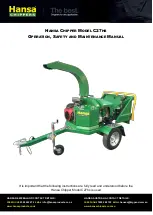
English
42/148
To change the oil:
- Place the machine on a flat, horizontal and
uncluttered surface.
Empty the engine oil:
- If it sucks the used oil: remove the engine oil plug
(Y1) and vacuum the motor oil by inserting the
Garland vacuum cleaner tube (REF.: 7199000020,
not included with machine) to the bottom.
- If you choose to empty the drain (Y2) through the
drain plug, please note the trajectory that the oil
will take into the chassis, place a large container to
catch all of the oil before it spills on the ground.
- We recommend that you put a big plastic covering
on the area in which you will change the oil so that
oil does not fall on the ground. Once the work area
is prepared, remove the filling cap (Y1) and remove
the (Y2) oil drain plug and slightly tilt the machine
so that the oil comes out and falls into the
container.
- Once all of the oil has been drained, put the drain
plug back in the machine.
- Empty the engine oil into a suitable container so
that you can carry it to a proper clean point.
Filling the oil sump:
- Place the machine on a flat, horizontal and
uncluttered surface.
- Unscrew the oil filler cap.
- Insert the filled 0,6 l of oil tube.
- Wait 1 minute for the oil to completely go down to
the crankcase.
- Clean the dipstick from the oil with a cloth.
- Insert the rod and screw on the oil cap.
- Unscrew the plug again and check the mark left
by oil on the dipstick. The mark left by the oil must
be between the minimum and maximum marks.
- If the mark is below the minimum, add a little more
oil and recheck.
- If the mark is above the maximum, you will have
to remove oil from the crankcase. To do this, tilt the
machine and let out a little oil (put a container
at the end of the tube to prevent oil spilling on the
machine or the ground).
8.2.3. CHECKING THE SPARK PLUG
When it comes to starting a machine, the most
common problems are produced by a dirty spark plug
or one in poor condition. Clean and check the spark
plug regularly.
Check that the electrode gap is correct (0.6 - 0.7
mm).
8.2.4.CLEANING THE CYLINDER FINS
The cylinder fins are responsible for the cooling of the
engine due to its contact with the air. These fins must
be clean and without any material including those that
limit the flow of air.
Y1
Y2
Summary of Contents for 1080 TQG
Page 11: ...Espa ol 11 148 4 5 6 7...
Page 25: ...Espa ol 25 148 NOTES...
Page 35: ...English 35 148 4 5 6 7...
Page 49: ...English 49 148 NOTES...
Page 59: ...Fran ais 59 148 4 5 6 7...
Page 73: ...Fran ais 73 148 NOTES...
Page 83: ...Italiano 83 148 4 5 6 7...
Page 97: ...Italiano 97 148 NOTES...
Page 107: ...Portugu s 107 148 4 5 6 7...
Page 121: ...Portugu s 121 148 NOTES...
Page 123: ...123 148 2 2 1 18 1 5bar max 1 9 bar 3 10 OFF 2 2...
Page 124: ...124 148 2 3 15 2 4...
Page 125: ...125 148 2 5 7 cm...
Page 126: ...126 148 2 6...
Page 130: ...130 148 6 6 1 6 2 3 1 2...
Page 131: ...131 148 4 5 6 7...
Page 132: ...132 148 6 3 6 3 1 1 2 3 4 3 6 3 2 4 20w 40 0 6 l 20W 40 0 6l...
Page 133: ...133 148 0 6 l 1 6 4 6 4 1...
Page 134: ...134 148 6 4 2 6 4 2 1 SC SC 6 4 2 2 A ON OFF ON B C SC SYSTEM OFF ON...
Page 135: ...135 148 D OPEN 1 6 4 2 3 A B 6 4 2 4 OFF OFF 7 3 SC ON...
Page 137: ...137 148 8 2 Y2 5 25 50 100 300...
Page 139: ...139 148 8 2 2...
Page 140: ...140 148 9 0 5 mm I sc 8 1 2 stick...
Page 141: ...141 148 0 I...
Page 142: ...142 148 10 5 10km h 11 5 0 C 45 C 12...
Page 143: ...143 148 13 13 1 1999 44 2 13 2 Garland Garland Garland 13 3 H Garland 13 4...
Page 145: ...145 148 NOTES...
Page 146: ...146 148 NOTES...
Page 148: ......
















































